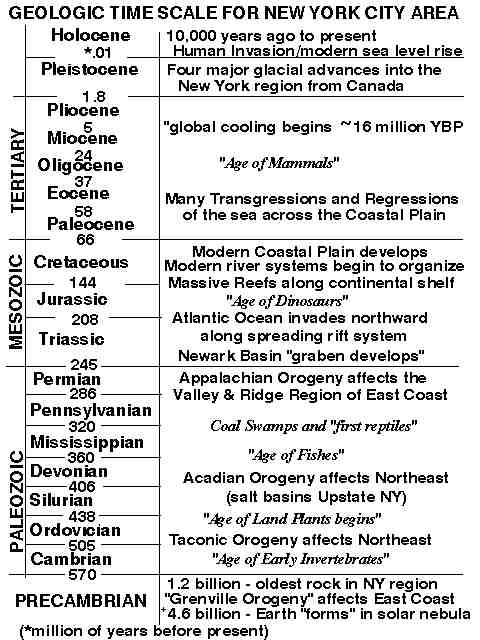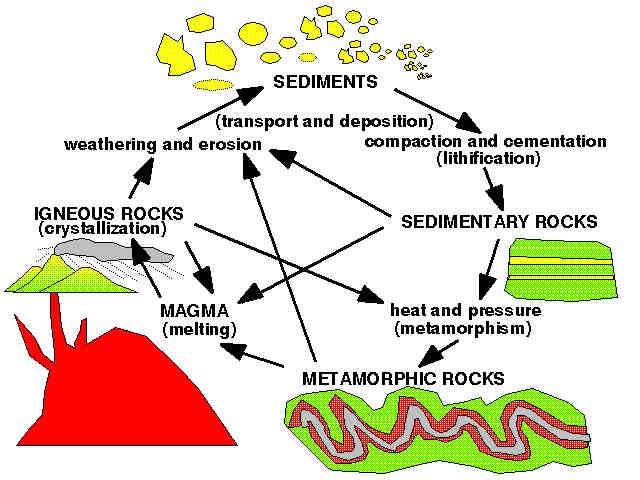CHAPTER 1: INTRODUCTION TO GEOLOGY, p. 1-25.
GEOLOGY - the study of the earth
"The most important factor in the study of the earth is the
concept of GEOLOGIC TIME and the antiquity of the Earth."
PHYSICAL GEOLOGY - examines materials composing the earth;
includes processes that operate beneath and on the surface.
HISTORICAL GEOLOGY - the study of earth's origin and its
development through time; strives to establish a orderly
chronological arrangement of the multitude of physical and
biological changes that have occurred in the past.
Geology is also an "environmental science:" it is essential for
understanding earth processes, and important to understanding
both natural and anthropogenic catastrophes.
CATASTROPHISM - earth's history influenced by great catastrophes
(influenced by biblical accounts of God's wrath and flood; a
popular theory during 17th & 18th Century (prior to methods of
systematic scientific inquiry). Beliefs included:
- canyons and mountain formed instantaneously.
- Anglican Archbishop James Ussher, studied the chronology of
births and events of the Bible and concluded that the earth was
"created" in 4004 BC.
UNIFORMITARIANISM - The theory that processes we see going on the
planet today are responsible for much of the features we see on
the planet (past and present). First publicly promoted by James
Hutton, a Scottish geologist (1729-1797) - Summary of Hutton's
idea: "The present is the key to the past." Uniformitarianism
suggests that slow processes, over great periods of TIME, can
account for most of the great features on the planet's surface.
Examples include:
- earthquakes (x time) = mountains
- stream erosion (x time) = canyons
- snow (and climate change) (x time) = glaciers
- gentle creep of continents across the Earth's surface (x
time) = oceans
- sand and mud from a river washing onto a coastline (x time) =
delta
- slow flow of lava on Hawaii = largest mountain (volcano) on
earth
Uniformitarianism illustrates that most geologic processes are
too slow to be witnessed by human lives. (An example: sea level
is currently rising at about 2mm per year.) However, some
processes do occur rapidly (catastrophically), examples include
asteroid impacts, major floods, landslides, massive earthquakes,
and volcanic eruptions. Modern theory incorporates both
theories.
EVOLUTION - The theory that over a great period of TIME life has
evolved from simple microscopic life forms to modern complex life
forms by the processes of genetic mutation and "natural
selection." (Charles Darwin wrote "Origin of Species by Natural
Selection" in 1859.)
GEOLOGIC TIME - current estimates is that earth "formed" around
4.6 billion years ago; the oldest rocks found on the surface are
about 3.8 billion
(old rocks crop out on coast of Greenland, core of Wind River
Mountains in Wyoming, Australia, Africa).
GEOLOGIC TIME SCALE [p. 8] - Names provided by geologists who
studied fossil-bearing rock sequences in many areas around the
world.

STRUCTURE OF THE EARTH
- INNER CORE - iron, solid, ~1200 km radius
- OUTER CORE - liquid metallic iron, ~2300 km thick
- MANTLE - dense rock, ~2900 km thick
- CRUST - "skin" of light rock, 5-40 km thick.
- AESTHENOSPHERE - hot weak zone 100-700 km below, capable of
flow.
- LITHOSPHERE - cooler, ridged rock upper mantle and crust
- HYDROSPHERE - oceans, lakes, rivers, glaciers
- ATMOSPHERE - air up to the vacuum of space
- BIOSPHERE - includes all life of earth within the earth,
water, and air
THEORY OF PLATE TECTONICS - "first proposed as continental drift"
The LITHOSPHERE consists of rigid PLATES floating on a dense,
viscous
AESTHENOSPHERE. Heat driving plate motion comes from earth
formation, radiation, unknown sources.
PLATE TECTONICS works like a "boiling pot with scum" - hot rock
rises, cooler denser rock sinks. Within the mantle hot areas are
rising beneath ocean ridges, cooler rocks are sinking beneath
plate convergent zones (such as around the edges of the Pacific
Ocean. The sinking rock around the edge of the continents are
full of water and trapped gas that cause some of the rock to melt
as it sinks. This molten rock rises to the surface and erupts as
volcanos along the sinking plate boundaries. (This process give
the Pacific Rim its name "The Ring of Fire.")
PLATES consist of rocks of differing densities:
Oceanic crust - density = 3.5 g/cm3
Continental crust - density = 2.7 g/cm3
The tectonic processes that affect the Earth's surface are most
active along the margins of PLATES. There are three types of
plate boundaries:
- DIVERGENT BOUNDARIES - where plates move apart and hot mantle
rocks are rising. When the hot rock reaches the surface it looses
pressure and melts (forming very HOT lava). The plates move apart
slowly. The process affecting the CRUST is called SEA FLOOR
SPREADING. For example, the Atlantic Ocean is spreading apart
along the Mid Atlantic Ridge at a rate of about 5cm per year.
- CONVERGENT BOUNDARIES - where plate collide mountains form,
such as the Himalayan Mountains. If denser ocean crust collides
with lighter continental crust the ocean crust sinks beneath the
continental crust and partially melts forming volcanos along the
continental plate margin. Examples include the Andes, the
Cascade Mountains in the US, the island arcs of the Aleutians,
Japan, Philippines, and Malaysia. Where one plate over-rides
another a deep ocean trench forms adjacent to a coastal volcanic
mountain range. This large feature is called a SUBDUCTION ZONE.
- TRANSFORM BOUNDARIES - where plates move past one-another,
causing major earthquakes: Examples include San Andreas Fault
and faults in the valley of the Dead Sea, Jordan, Israel, and
Egypt.
THE ROCK CYCLE
The ROCK CYCLE represents a flow chart showing natural processes
and earth products.

Important concepts of the rock cycle include:
- IGNEOUS ROCK - forms from the solidification of molten rock
- MAGMA - molten rock underground
- LAVA - molten rock on the surface.
- CRYSTALLIZATION - the process of cooling and solidifying
magma.
- WEATHERING - processes that break down rocks (chemical or
mechanical)
- SEDIMENT - rock particles or precipitates deposited
- LITHIFICATION - processes that bind sediment into rock
- SEDIMENTARY ROCK - rock consisting of cemented sediments.
- METAMORPHIC ROCK - great heat and pressure physically and
chemically change the rock.
RENEWABLE vs. NONRENEWABLE RESOURCES
Mining depletes resources through time. The Earth's crust only
has a limited supply of resources - a great concern for the
future of the world's growing population...
Non-renewable resources include: coal, oil, gas, minerals,
metals, and soil.
Renewable resources include: wood, wind, water, oxygen, land
 Click here to
return to the Class Website
Click here to
return to the Class Website

 Click here to
return to the Class Website
Click here to
return to the Class Website